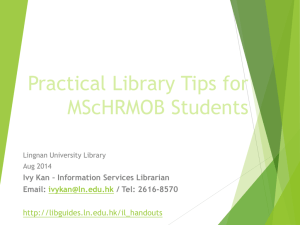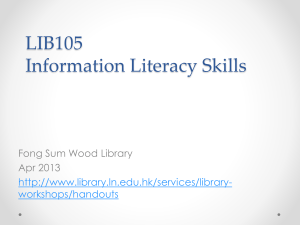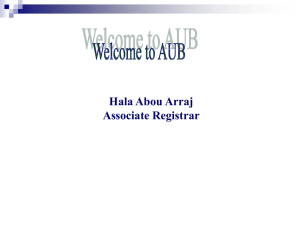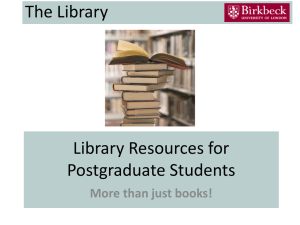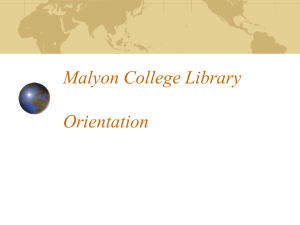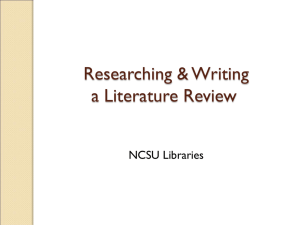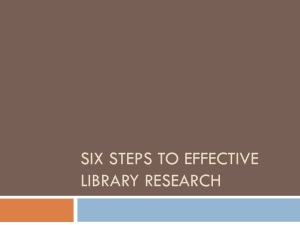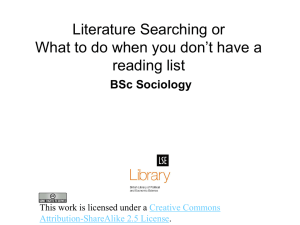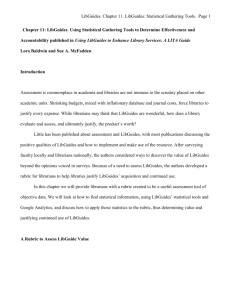Examples of "Primary Sources"
advertisement
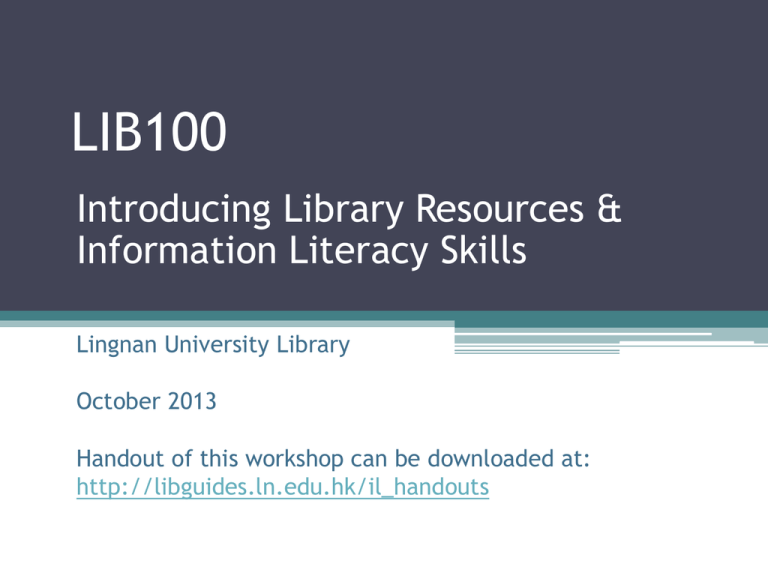
LIB100 Introducing Library Resources & Information Literacy Skills Lingnan University Library October 2013 Handout of this workshop can be downloaded at: http://libguides.ln.edu.hk/il_handouts 2 After this workshop, you will be able to: Identify and evaluate various resources from the Library and on the Internet Identify the functions of the online Library Catalogue and 1-Search, and learn the basic searching strategies Identify the self-help guides and popular online databases that the Library provides Have basic understanding on citation and avoiding plagiarism 3 Part A - Search for information in the Library Website Have a quick tour of the Library Website Understand a reading list Perform Author Search in the Library Catalogue Perform Advanced Search in the Library Catalogue View Bibliographic Records Access My Library Account Understand the Library of Congress (LC) Classification Scheme 4 Quick tour of the Library Website We shall begin with http://www.library.ln.edu.hk/ Different user groups Search box Quick links E.g. My Library Account, Databases, Room Booking System, etc. 5 Pull down menu of Library Website A hub to find out most of the resources, services and facilities available in the Library Website 6 How to understand a reference in a reading list Example: Book Author Year of publication Title Coupey, E. (2001). Marketing and the internet. Upper Saddle River, NJ: Prentice Hall. Publication place Remarks: APA Style is used in this example Publisher 7 How to understand a reference in a Reading List Example: Journal Article Author Year of publication Title of the journal article Street, S. (2006). A Darwinian dilemma for Title of the realist theories of value. Philosophical journal Studies, 127(1), 109-166. Volume number (Issue number) Remarks: APA Style is used in this example Pages 8 How to understand a reference in a Reading List Example: Book Chapter Author of the chapter Title of the chapter Year of publication Parton, N. (2012). Thinking and acting Editor of the book constructively in child protection. In S. L. Witkin (Ed.), Social construction and social work practice: Interpretations and innovations (pp. 127-153). New York: Columbia University Press. Title of the book : capital letter also for subtitle Remarks: APA Style is used in this example Publisher Pages of chapter Publication place 9 Scenario one: If I already know the author’s name of a book… Q: I want to read the book written by Suzanne Collins in 2008. However I forget the title of the book, what should I do? A: Search the Library Catalogue by Author. Be sure to search by placing the SURNAME in front of the first name. In this example, you should search “Collins, Suzanne” 10 Scenario two: If I want to find books for my research project but do not know the name of the author / title of the item… Q: My instructor asked us to watch some local TV programmes about drug abuse cases in Hong Kong, produced in 2013. How can I find it? A: 1. Search the Library Catalogue by keywords (“drug abuse”, “hong kong”) in the Advanced Search page 2. Then, limit the Material Type as “Local TV Programme” 3. Limit the Year as “After 2012” 11 Viewing Bibliographical Records After searching for books or other items in the Library Catalogue, here below are important tips for you to find out WHERE the book is: LOCATION of the item (where it is stored) CALL NUMBER of the item (the exact address) STATUS of the item (available now or not) For more details of the definitions of “LOCATION” and “STATUS” codes, please refer to: http://libguides.ln.edu.hk/catalogue_codes 12 View Bibliographic Records in the Library Catalogue Example 1: If the item is AVAILABLE, you can: 1. Click / view the “LOCATION” to see where the item is placed 2. Follow the “CALL NUMBER” to find the item from the bookshelf 1. Click the link to view the location map 2. Follow the call number to find the item on the bookshelf It means the item is available for borrowing View Bibliographic Records in the Library Catalogue Example 2: If an item is currently checked out (i.e. with a due date) or on-hold, you can try alternatives: 1.Click the relevant subject to find related works 2.Request/Hold the item and get notified when it is returned to the Library (for books only) 3.Search for HKALL to see if other University Libraries have this item available (for books only) 3. Search HKALL 2. Request to wait for the item 1. Click on any subject and you can see related items in the Library It means the item is currently checked out 13 14 More Tips on Using the Library Catalogue General Search Tips for the Library Catalogue: http://libguides.ln.edu.hk/search_tips About Library Catalogue: http://libguides.ln.edu.hk/opac 15 My Library Account Use Lingnan Email / password to login Check your borrowing records Make online renewal Check your reading history Register for SMS Alert Service to receive library notices Modify your PIN for login to the Library Account (but CANNOT modify your email password there) 16 Brief Introduction to Library of Congress Classification Scheme http://libguides.ln.edu.hk/content.php?pid=3385 19&sid=2768286 Classification of major subjects in Lingnan Call number locations in the Library Know about shelf order Online game: to arrange the books in the Library of Congress Classification order: http://www.lcsc.edu/library/satchlcall/ 17 Part B – Identify various sources Primary VS Secondary Sources Scholarly Journals VS Popular Magazines 18 Primary Sources VS Secondary Sources What is "Primary Sources"? “First-hand" information Mostly gathered from the participants/witnesses of an incident Usually written/recorded in a very short time after the event happened Examples of "Primary Sources" Newspaper articles (reporting an incident) Statistical data Records of organizations Interview transcript Importance of “Primary Sources” It presents a strong proof for your comment or argument, which makes your research paper more reliable 19 Primary Sources VS Secondary Sources What is "Secondary Sources" ? Information written based on the "Primary Sources" It is produced after the "Primary Sources" have been analyzed, commented, evaluated or filtered Examples of "Secondary Sources" Editorial in a newspaper Research journal articles Report findings of a survey Importance of “Secondary Sources” Inspire you to think more and give you more insight of the research question 20 Scholarly Journals VS Popular Magazines You can search the journal titles in the Library catalogue (http://www.library.ln.edu.hk/#tabs3) or from the 1-search (http://www.library.ln.edu.hk/find/1-searchsearchbox). For magazines and journals, they are located in the "Serials Collections" or "Compact Shelves" of 2/F South Wing of the Library; a few popular magazines are available at 1/F Reading Room of the Library. 21 Scholarly Journals VS Popular Magazines Journals, serials and periodicals are publications that published continuously over a period of time Scholarly Journals Also known as peer reviewed journals or referred journals. Author's credentials are provided; usually a scholar or specialist with subject expertise. Articles are evaluated by peer-reviewers or referees who are experts in the field; edited for content, format, and style. Nearly all the journals are specialized in certain subject areas. A plain format with less design in the content. Target audience is scholars, researchers and students. References are provided in the footnotes or at the end of an article. Popular Magazines Published frequently. Author is frequently a journalist paid to write articles, may or may not have subject expertise. Articles are evaluated by editorial staff, not experts in the field; edited for format and style. Deliver the information that is of interest to general public. Attractive covers and nice looking design in the contents. Target audience is the general public. References and citations of the sources may not be provided. Examples: American Journal of Psychology, Harvard Business Review. Examples: Time, National Geographic. 22 Importance of identifying various sources You should know what are you citing and making reference to when you are doing your research paper. If your assignment contains primary and secondary sources, it will certainly gain better reliability and authority. 23 Quiz (Part A): Please click the following: https://docs.google.com/forms/d/1ejy9LUfNI9pFzqFu PuYZpBJ4lQm7ASeaNTmg7yL179Y/viewform This quiz is also available at: http://libguides.ln.edu.hk/quiz 24 Part C - Search Strategies 25 Searching strategies (1) Step 1 – Identify key concepts You should be clear about the key concept(s) you are going to search Key concepts can be: author’s name of a literature work keywords of your research theme country/place of a phenomenon appeared/an incident happened You could also decide what sorts of Library materials you will use. For example, are you searching for : some journal articles about your research topic? a book for your self-interest? a local TV programme for presentation use? 26 Searching strategies (2) Step 2 – Selection of search words Use related words/synonyms to build up a series of keywords for searching If you cannot think of the synonyms, you can use the Thesaurus or dictionaries to help Always combine different keywords to have more search results Step 3 – Use of operators to control the search Boolean Operators Wildcard / Truncation Parentheses 27 Step 3(1) - Boolean Operators (AND, OR, NOT) AND: searches records that contain both search terms, this narrows down the search result OR: finds records in which anyone of search terms appears, this broadens the search result NOT: finds records in which a specific term is excluded, this narrows down the search result but with the risk of excluding useful records Practice: - Crime AND youth - Crime OR youth - Crime NOT youth 28 Step 3(2) - Wildcards / Truncation Wildcards / Truncation: retrieves all variant endings of that keyword, this broadens the search result. Most systems regard * as a truncation mark OPAC: * 1-Search* EBSCOhost: * ProQuest: * LexisNexis Academic: ! Practice: Try to type politic* and “hong kong” to see the results. 29 Step 3(3) – Parentheses Parentheses( ): group words together, and gives priority and order in a search statement, this broadens the search. Practice: (sales tax OR vat OR value added tax OR gst) and hong kong 30 Step 3(4) – Quotation Marks Quotation Marks “ ”: search the words as an exact phrase, this narrows down the search result. Practice: “social movement theory” VS social movement theory 31 Scenario in constructing a search (1) Q. I would like to do a research paper on the impact on children’s behavior by domestic violence. How can I construct a search for this theme? 1. Identify keywords from the research theme: domestic violence child / children behavior impact 32 Scenario in constructing a search (2) 2. To form related keywords. E.g.: domestic violence => family violence impact => effect 3. To combine keywords and use the Boolean operators/wildcards/parentheses to form the search “(domestic OR family) violence” AND child* AND impact “(domestic OR family) violence” AND child* AND behavior 33 Part D – Introduction to guides and popular databases Survival Guide for New Students Guides @ LU Databases Off-campus Access to Databases 34 Survival Guide for New Students A good starting point for you to know the library services and facilities http://www.library.ln.edu.hk/services/information-services/survivalguide-new-students-getting-started 35 Guides @ LU A portal to databases, subject guides and various user guides on library services and facilities http://libguides.ln.edu.hk/ 36 37 Databases Electronic databases provides information at different levels. Depending on whether it is a full text database or bibliographic index database, it will provide the article level information, table of contents and often the full-text. Access ALL library-subscribed databases in one link: http://libguides.ln.edu.hk/databases OR Click the “Databases” quick link on the righthand corner of Library Website 38 1-Search Allows searching across library catalogue records, major subscribed full-text databases, research in Digital Repository, etc., at the same time NOT a substitute for any individual database http://www.library.ln.edu.hk/find/1-searchsearchbox 39 Off-campus Access to Databases If you are accessing the databases off-campus (e.g. at home), you will be asked to login-in with your Lingnan email username and password before going into the search pages of databases. Alternatively, you can install SSL VPN provided by ITSC. Click here for more details: http://www.ln.edu.hk/itsc/network/vpn 40 Part E – Introduction to plagiarism and citation Definition of plagiarism Importance of citation RefWorks 41 What is Plagiarism? According to Oxford English Dictionary (2012), plagiarism (學術剽竊) refers to: the action or practice of taking the work, idea, etc. of someone else, and passing it off as one's own; literary theft. a particular idea, piece of writing, design, etc., which has been plagiarized; an act or product of plagiary. To learn more about plagiarism : http://libguides.ln.edu.hk/cite_resources 42 Plagiarism & Citation In order to avoid the trap of plagiarism, we need to properly provide citations to ALL the resources (e.g. books, journal articles, websites) that we have made reference to in our research paper. Citations are the key information of each piece of resource. It often includes : Book chapter title / Journal article title / Webpage title Book title / Journal title Authors (and editors) Volume no. , issue no. & page no. of the journal article in the journal Publisher and publication place of the book Address of the webpage (if the article is retrieved online directly) 43 Importance of Citation It gives a kind of “credit” to the authors of information that contribute to your research paper It can add the creditability (reliability) of your research paper Readers of your research paper can refer to the citation list and find out more sources related to your topic Learn more about citation and plagiarism: http://libguides.ln.edu.hk/bibliography_plagiarism 44 RefWorks Reworks is an online citation management tool, which is an easy and convenient software to build-up and manage your citation. After building-up your citation, you can export your citation list to a Word file or email. Guide on RefWorks : http://libguides.ln.edu.hk/ refworks There will be training workshop on using RefWorks by the Library. Please pay attention to our announcement. 45 Information Technology Fluency (ITF) Test With effect from 2012-2013, all undergraduate students (both 3year and 4-year programmes) are required to pass the ITF Test during their study at Lingnan More details: http://tlc.ln.edu.hk/itfp/ 46 Quiz (Part B): Please click the following: https://docs.google.com/forms/d/1gpnRFSBgNmEt6F9 ALIAdC0BruIA7-wsWAtKnYnKr_sg/viewform This quiz is also available at: http://libguides.ln.edu.hk/quiz 47 Need Help? Phone: 2616 8571 Email: refstaff@ln.edu.hk Chat with a Librarian at: http://www.library.ln.edu.hk/research/ask-librarian 48 We need your feedback to this workshop ~ Click the following URL to access the online evaluation form of this library workshop, http://lingnan.asia.qualtrics.com/SE/?SID=SV_dfXUt8 sOqIiH2OV ~ Thank you~
